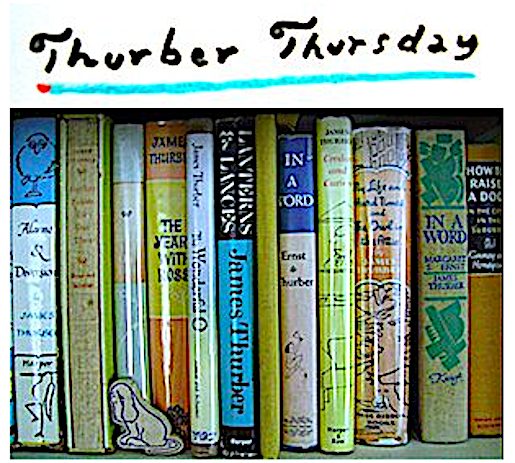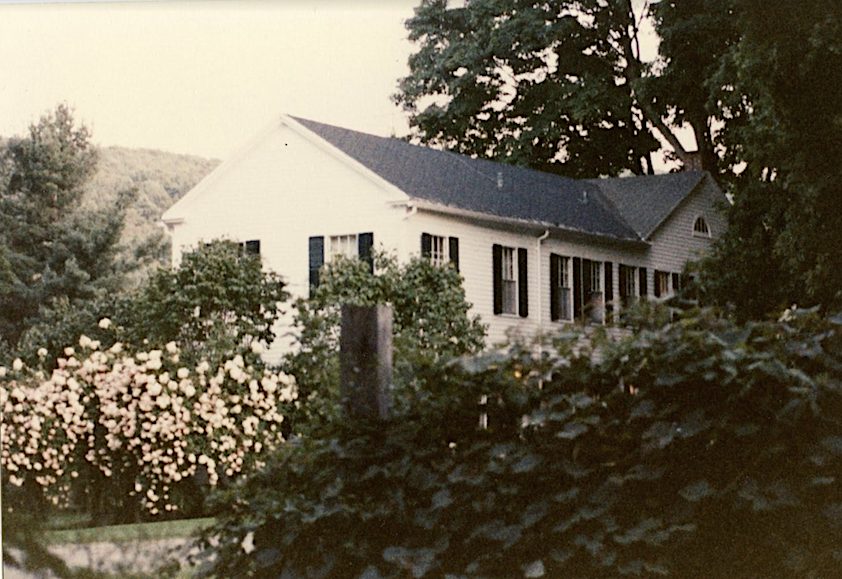In the Fall of 1986, Liza Donnelly, and I went for a drive in northwestern Connecticut to find the home James Thurber lived in from 1945 until he passed away in 1961. All we had to go on was a photo that appeared in Burton Bernstein’s Thurber biography (the photo identified the home as “the great good place”), and that the house was in West Cornwall, with a “valley view.”
Below: the photo in Burton Bernstein’s Thurber biography.
At the time of our Thurber adventure, Liza and I were living in a rented tumbledown cottage right next to the Appalachian Trail, less than an hour from Cornwall. As these were pre-GPS days, and even pre-home computer days, we just had a paper map to help us find our way.
Arriving in Cornwall proper, we thought about asking someone where the house was, but there wasn’t a soul in sight (I believe we went into the Historical Society — it was open, but unattended. I vaguely remember seeing a small display of Thurber books there). So we decided to ride around. Bernstein’s mention that the house had a “valley view” led us to head for the hills.
What I remember from the Cornwall day is this: we drove and drove. Beginning to feel defeated and about to call off the search, we zoomed past a row of tall bushes (hedges?) that somewhat obscured a house. We took a quick look over as we passed the driveway, where the privacy row of bushes or hedges ended, and bingo! There it was. It wasn’t the angle we were used to from Bernstein’s book, showing the house head on. This is what we saw that day (Liza took the photo):
We didn’t have much time to soak up the vibe as we immediately noticed that a fellow who had been mowing near the back of house was now walking our way. It was the owner, the actor, Sam Waterston. Not wanting to intrude, (we were there to see the house, not to star gaze, or invade anyone’s privacy),* we drove away. That first sighting — the discovery — was such a thrill (much like seeing Thurber’s drawings on the wall in The New Yorker‘s old offices at 25 West 43rd Street).
Bernstein wrote, in part, about Thurber and his Cornwall home:
“Of all the towns and cities he had lived in for half a century, Cornwall was the place where he was most at ease. It was, for the rest of his life, his “beautiful house” and his “beautiful trees,” even if he had no eyes to see them.”
______________________________________________________________________
Thurber: A Biography by Burton Bernstein, published 1975 by Dodd/Mead.
* You might think I’m invading Mr. Waterston’s privacy now by mentioning his name, but his ownership of Thurber’s house has been cited in numerous articles over the years, including a number of New York Times articles. In other words: it’s no secret.
_______________________________________________________________
Thurber’s A-Z entry:

James Thurber Born, Columbus, Ohio, December 8, 1894. Died 1961, New York City. New Yorker work: 1927 -1961, with several pieces run posthumously. According to the New Yorker’s legendary editor, William Shawn, “In the early days, a small company of writers, artists, and editors — E.B. White, James Thurber, Peter Arno, and Katharine White among them — did more to make the magazine what it is than can be measured.”
Key cartoon collection: The Seal in the Bedroom and Other Predicaments (Harper & Bros., 1932). Key anthology (writings & drawings): The Thurber Carnival (Harper & Row, 1945). There have been a number of Thurber biographies. Burton Bernstein’s Thurber (Dodd, Mead, 1975) and Harrison Kinney’s James Thurber: His Life and Times (Henry Holt & Co., 1995) are essential. Website





Michael: What a joy to find this entry. When I was a kid my old man (Jerry Dumas) befriended Thurber’s widow, Helen, and we used to go visit her at this house. I remember that in the living room Thurber’s huge magnifying glass was set up as if he were still alive; there was a drawing of a Thurber dog under it. Last time I went looking for the house (a year ago?) I came up empty. —-Timothy Dumas
As usual, I find myself on your site when I’m trying to find out something about a New Yorker—thank you! I came across a mention of “Jim…a New York writer who lives in our town all year” and his wife Helen “a minister’s daughter” in Dorothy Van Doren’s A Country Wife. I figured out it was the Thurbers, and then found the above. Always appreciate your posts!